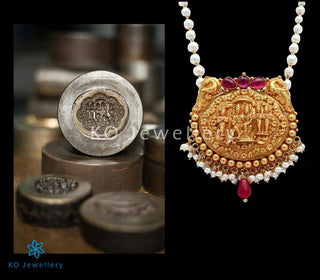What if we told you that the piece of jewellery that adorns your neck speaks the language of the myths, represents the distilled wisdom of the ages, and has been influenced by Greek techniques?
Intrigued? Well read on for this is the story of `Nakkasi’ the jewellery that truly brings the Gods to life…
One of the three main jewellery techniques of South India – the other two being `Kundala velai’ (similar to kundan of north India) and `Kall-velai’ (closed setting of gemstones) , nakkasi has been very typical to South India, and has developed its own unique character.

Tracing the origins of Nakkasi
Nakkasi is known by various names like repousse sheet gold technique, nakashu velai, nakkashi, nakshi, embossing and micro repousse .
Repoussé is French and means "pushed up" while Chasing (which is the opposite of repousse) means to drive out, or to chase around which is what the artists are doing as they "chase" the forms on their metal in order to create their final design.
One of the oldest methods of jewellery making , repousse has been used since antiquity by the Greeks and Romans. It was used on gold/ silver for fine detailed jewellery or objects ; and on copper, tin/ bronze for larger sculptures. The earliest example of repousse is a bronze Greek armour plate from the 3rd century BC.
While in recent times the largest known sculpture created with this technique is the Statue of Liberty which has been formed by copper repoussé.

In India sheet gold jewellery filled with lac was found in the Indus Valley civilization, along with jewellery moulds. The practice of filling hollow pieces with a lac core (which is one of the main features of South Indian Nakkasi) is believed by scholars to be of Greek origin. Therefore we can safely assume that designs and manufacturing techniques travelled the trade routes from one region to the other.
Asvaghosha (the Buddhist writer) mentions the Nakkasi process in 1st century AD while Domingo Paes (Portuguese traveller) in 1520 describes a throne in the court of Vijayanagar (Hampi,Karnataka) decorated with Nakkasi .South indian jewelers displayed an extraordinary skill in working with sheet gold .The goldsmiths knowledge of metallurgy was very advanced and it looks as though they were influenced by the brass repousse work that was used to ornament temple doors and columns. Nakkasi on jewellery was in a sense a scaled-down version of this work.

The technique of Nakkasi
Silver or gold of high purity is beaten into a thin sheet and the desired image/design is reproduced on this sheet through stamping, repousse or moulding. Further decorative details are then executed on the surface with fine etching and engraving tools.
Next, a thin plate of gold or more oftenly silver is fixed to the back, which has a tiny hole in it. The completed piece is then filled with lac to retain the form of the piece as the sheet is thin.

In large ornaments all individual components are made separately and then assembled together. The units are either strung on a cord or chain or linked together.
Nakkasi technique enables the jeweler to shape gold into fabulous forms and decorate it with complex designs often enhanced with gemstones. One major reason for the popularity of nakkasi was that since gold was precious and scarce this technique made sure a little gold went a long way by keeping the jewellery light as thin sheets only were used.
“ The repousse technique employs a very small quantity of metal , beaten to paper thinness and then worked in such detail and opulence that it manages to convey an impression of weight and solidity, so that every design detail stands out in almost three-dimensional relief. Gods, humans and animal figures are set amidst dense foliage and scrolling cartouches, with petalled borders along the edges. The technique provided the jeweler with a canvas which he liberally utilized to tell a story. Religious myths , legends and folklore became popular subjects” – Usha Balakrishnan “Dance of the Peacock, Jewellery Traditions of India”

Its use of mythology
For the jewellery lover the most striking and unique feature of Nakkasi jewellery is its use of mythology. Nakkasi art in jewellery is like a canvas that tells stories from mythology - a painting crafted in gold. The pieces tend to be narrative in character and have a rich symbolism , like temple architecture the images used have a distinctive meaning and are based on hindu mythology.
One look at pieces like the Gowrishankaram necklace (which is a miniature Shiva shrine depicting Shiva & Parvati seated on the bull Rishabha) ; the Dashavatara waistbelt (with all ten incarnations of Vishnu) or the Jadai nagam (an elaborate ornament for the hair) and we can see how each piece makes up a story in itself.

“Handmade and painstakingly crafted, each ornament is the culmination of a creative process combining artistic genius, technical prowess and manual dexeterity, made with an attention to detail that could only be the product of love and dedication.” ibid
True, the templates are set as the jewellery is crafted using ready moulds or dyes but using these templates in various permutations and combinations- a sense of drama is created and the flexibility that this form gives is truly wonderful.
- Priya Revankar
Read more in part 2 of this blog, here....



Varun
Great jewellery
Hafeez Ahmad
Nice post i like your post.